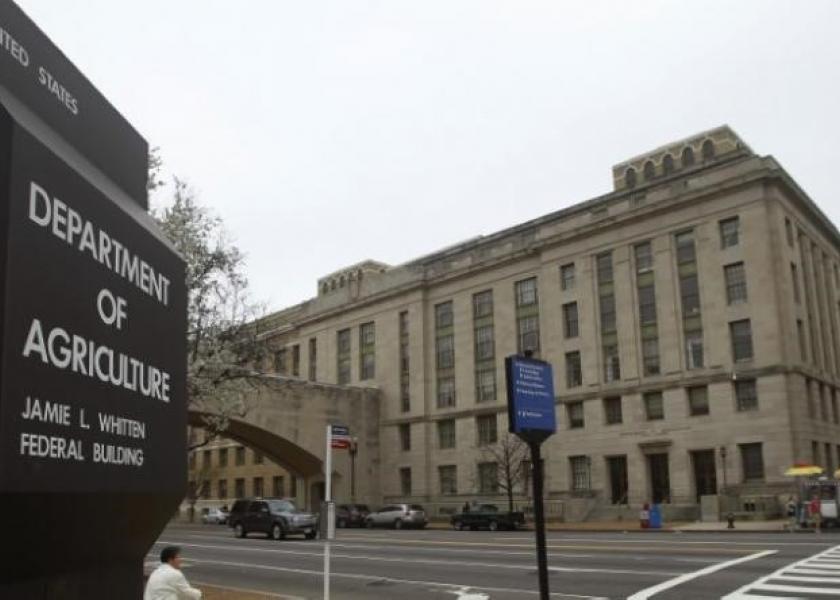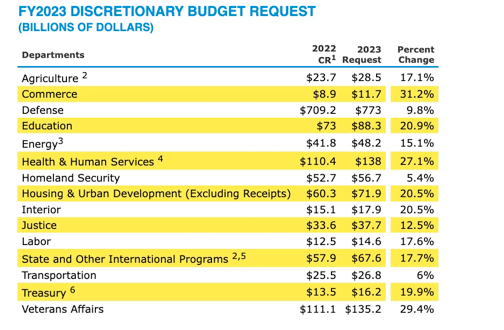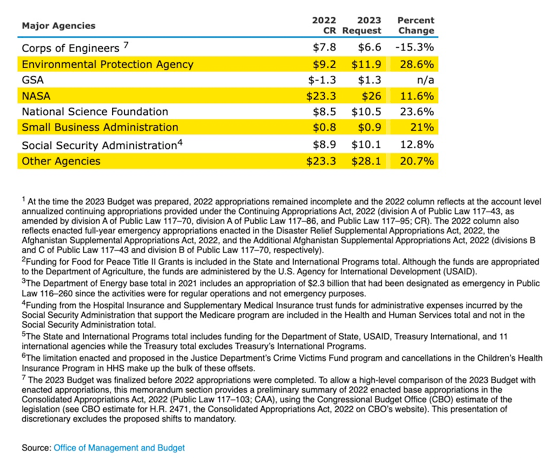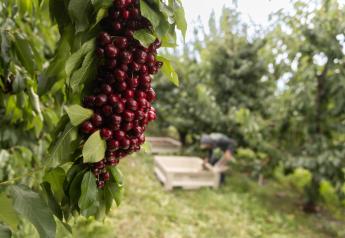Biden's USDA Budget Proposal Seeks Big CRP Boost with $2.4B to Enroll Targeted 27 Million Acres

Biden’s budget proposal is mostly a wish list, as the 12 appropriations measures that fund the government are ultimately approved by Congress. Hence, the president’s budget mainly serves as a messaging tool for the administration.
In Biden’s FY 2023 budget proposal, some of the key priorities include:
- The budget would bolster domestic spending by 7% from current levels, to roughly $1.6 trillion.
- Boost defense spending by 4% from fiscal 2022 to 2023. Biden called for the largest-ever level of military spending and increased funding for law enforcement in a $5.8 trillion budget, playing down his proposals for expanding social programs in favor of backing initiatives generally favored by centrist lawmakers. The budget proposes $773 billion for the Department of Defense, compared to $728.5 billion provided in discretionary spending in 2022. “To sustain and strengthen deterrence, the Budget prioritizes China as the Department’s pacing challenge,” the White House stated. The budget also includes nearly $1.8 billion for the State Department and USAID “to support a free and open, connected, secure, and resilient Indo-Pacific Region and the Indo-Pacific Strategy,” as well as $400 million for the “Countering the People’s Republic of China Malign Influence Fund.” Cybersecurity is also a major security concern reflected in the budget.
- Ukraine aid: Proposed economic, humanitarian, and security assistance to Kyiv, Ukraine. The budget allocates roughly $682 million in aid to Ukraine.
- Law enforcement funding: Allocates $3.2 billion in discretionary funds for state and local grants, as well as $30 billion in mandatory funds to “support law enforcement, crime prevention, and community violence intervention.” There will be more community police officers on the streets across the country under this plan, White House officials said. The plan also proposes to increase the capacity of federal law enforcement agencies such as the FBI and the U.S. Marshals Service to fight violent crime.
- Tax on ultra-rich. Biden is asking Congress to approve legislation that requires the richest U.S. families to pay a minimum of 20% on all of their income, including capital gains on unsold assets such as stocks. (In 2020, there were fifty Fortune 500 companies that made profits of over $50 billion, but they didn't pay anything in federal taxes.) Capital gains are only taxed when they’re realized — when the assets are sold — under current law. Only the wealthiest 0.01% of U.S. households (those worth more than $100 million) will be subject to the tax, according to the plan. Households earning more than $1 billion will account for more than half of the revenue, the White House stated in a fact sheet. However, centrist Sen. Joe Manchin (D-W.Va.) said the idea is a “tough one.” You can’t be taxed “on things you don’t have,” he said. “You might have it on paper. There are other ways for people to pay their fair share, and I think everyone should pay.” Manchin’s early opposition comes as Senate Finance Committee Chairman Ron Wyden (D-Ore.) said he wants to hold hearings to build support for Biden’s proposal. Manchin’s support would be needed to ram the new tax through the 50-50 Senate using a budget procedural maneuver to bypass a Republican Senate filibuster.
- Infrastructure: It calls for broad increases in funding for the Transportation Department to modernize roads, bridges, ports and public transit systems. The budget includes about $115 billion in funding that was part of the infrastructure bill passed by Congress last year.
- Climate: It seeks $45 billion to address climate change — an increase of nearly $17 billion from the year before — for the five major agencies tasked with addressing environmental risks. The president also proposed $11 billion to help other countries hit hard by global warming. The budget calls for a record $11.9 billion in funding — a 28.8% increase — for the Environmental Protection Agency that includes increases in spending for environmental justice efforts, staffing and air, water and chemicals programs.
- Health: The administration asks for a major increase for the FDA’s budget to prepare for another pandemic. The agency’s budget would rise by a third, to $8.4 billion.
- Space funding: The plan includes $26 billion for NASA — the largest request for science in the space agency's history — setting the stage for human exploration on Mars.
- Biden wants to give nearly every agency a big budget boost: The Commerce Department would see the highest percentage increase of the Cabinet departments at 31.2%, moving from $8.9 billion under the CR to $11.7 billion under Biden’s request. This would be closely followed by the Veterans Affairs Department, which would see a 29.4% boost from $111.1 billion in the CR to $135.2 billion under the request. USDA’s increase would be 17.1%.


A Look at USDA Proposed Budget
USDA FY 2023 budget proposals focus on climate, conservation & research. The White House fiscal year (FY) 2023 budget proposals include a $3.8-billion discretionary spending increase for USDA, with climate, conservation and clean energy again major focal points.
Highlights include:
- Plan requests $31.1 billion in discretionary spending for USDA, a 12% increase over the FY 2021 enacted level. On the mandatory spending side, which includes farm bill commodity and conservation programs, the budget estimates spending at $164.8 billion, $14.7 billion less than FY 2021 enacted levels. Across mandatory and discretionary spending, USDA’s FY 2023 request is $10.2 billion under FY 2021 levels at $195.9 billion. Outlays for mandatory programs in FY 2023 are estimated at $164.4 billion, or 80.9% of total outlays of $209.3 billion.
- Climate change and conservation: Includes $1.8 billion for climate-related initiatives, with $300 million in new funding aimed at helping rural utilities transition to carbon-free energy sources by 2035. Another $15 million was requested to support increased coordination between USDA, the Department of Energy (DOE), and the Department of Interior to “support the creation of the Rural Clean Energy Initiative” supporting work to reach President Joe Biden’s clean energy goals.
- For USDA’s Agriculture Buildings and Facilities account, the request seeks $134.8 million, $25 million of which is aimed at hiring and buying “hybrid, alternative, and/or electric” vehicles and providing associated charging infrastructure.
- For Natural Resources Conservation Service (NRCS), the budget plan seeks more than $1 billion in discretionary spending for conservation-related technical assistance in FY 2023, up from $832 million in FY 2021 and 2022. Including mandatory spending — such as for programs including the Environmental Quality Incentives Program (EQIP) and the Agricultural Conservation Easement Program (ACEP) — the plan eyes $2.74 billion, down slightly from $2.96 billion in FY 2022 and $2.93 billion in FY 2021. The request included $21 million to support key climate priorities at NRCS, “including establishing a soil health monitoring network that will include a network of soil sampling sites, integrating soil carbon monitoring into the conservation planning process, and efforts to increase the internal capacity of NRCS staff regarding key soil carbon and climate-smart activities.”
- For the Conservation Reserve Program (CRP) the request seeks $2.4 billion to help enroll up to 27 million acres of environmentally sensitive cropland and grassland — the statutory acreage cap in place for FY 2023 under the 2018 Farm Bill.
- For staffing at the NRCS, the request seeks funding for an estimated 11,746 employees at the service in FY 2023 — 655 more than provided for under FY 2022 spending levels (a 2,000-employee increase over what the agency had in FY21). For the Farm Service Agency (FSA), the budget request seeks funding for an estimated 3,157 employees, an increase of 79 from FY 2022 levels. Notably, across all agencies, the request seeks an additional $365 million spending bump to cover 4.6% pay increases for all USDA workers.
- Other conservation program highlights:
- $2 billion for EQIP, up $175 million from FY 2022.
- $1 billion for the Conservation Stewardship Program (CSP), up $200 million from FY 2022.
- $450 million for ACEP, the same as FY 2022.
- $300 million for the Regional Conservation Partnership Program (RCPP), the same as FY 2022.
- Ag research spending would also see a boost under the FY 2023 plan, which seeks $4 billion for ag and food research programs—above FY 2022’s $3.5 billion level—to “support research to advance the competitiveness of US agriculture, promote food security and increase climate change research.” At USDA’s Agricultural Research Service (ARS), the plan looks for discretionary spending of $1.9 billion, up from $1.6 billion in FY 2022. That includes increases of $127 million for “climate science and adaptation and resilience research,” $101 million for clean energy research and development, $5 million for USDA Climate Hubs, and $75 million for “additional high priority investments.”
- ARS’ budget also seeks a $48 million spending increase for research and operations at the National Bio and Agro-Defense Facility (NBAF), the department’s state-of-the-art facility for the study of emerging and zoonotic animal disease threats. Another $45 million is earmarked for NBAF capital improvement and renovation and construction at the Beltsville Agricultural Research Center (BARC) in Maryland.
- At the National Institute of Food and Agriculture (NIFA), the budget blueprint proposes discretionary spending of $1.8 billion, up from FY 2022’s $1.6 billion. For NIFA’s Agriculture and Food Research Initiative (AFRI), the request eyes a $129 million increase in discretionary spending over FY 2022, to $564 million. USDA says there will be “a broad emphasis on climate-smart agriculture, nutrition security, and the application of clean energy” at AFRI, and describes the additional funding as supporting the administration’s “whole-of-government” approach to addressing climate change.
- USDA’s Economic Research Service (ERS) discretionary spending is requested at $100 million for FY 2023, up from $85 million in FY 2022. USDA said $2 million of the increase will be used to support climate science activities. The request seeks $217 million in discretionary spending at USDA’s National Agricultural Statistics Service (NASS), up from $184 million in FY 2022.
- Market enforcement and department oversight: The Biden administration has placed an emphasis on the need to strengthen the enforcement of rules aimed at ensuring fairness in livestock markets and has highlighted market concentration — including across the ag sector — as a key issue. Part of that push are new USDA rulemakings focused on the Packers and Stockyards Act (P&SA), with the FY 2023 request seeking an additional $12 million in discretionary spending “to fund new statutory requirements, to strengthen oversight of livestock and poultry markets and minimalize IT security vulnerabilities,” related to P&SA activities.
- For USDA’s Office of the Inspector General (OIG), the request eyes discretionary spending at $112, up from $109 million in FY 2022 which also included $9 million set aside for one time audit and investigation outlays.
Other highlights:
- Trade. Spending for USDA’s Foreign Agricultural Service (FAS) would see little change under the FY 2023 request, with most additional discretionary spending focused on salaries and expenses, and other line items largely the same as FY 2022 marks. Overall, FAS discretionary spending is requested at $2.217 billion, up from $2.198 estimated for FY 2022.
- Rural broadband. USDA’s ReConnect rural broadband grant and loan program would see a funding boost under USDA’s FY 2023 request. The request eyes $113 million in additional funding for ReConnect over FY 2022 enacted levels—to $600 billion.
- Rural business loans. The request looks for a large funding increase for the Rural Business-Cooperative Service’s (RBCS) Business and Industry (B&I) Guaranteed Loan Program, seeking $1.5 billion for B&I loan guarantees—nearly $600 million over FY 2021 and almost $1 billion over FY 2022 enacted levels.
- SNAP & WIC. The budget request proposes $111 billion in funding for the Supplemental Nutrition Assistance Program (SNAP), enough to cover 43.5 billion beneficiaries per month. Meanwhile, it seeks to hold funding for the Special Supplemental Nutrition Program for Women, Infants and Children (WIC) at $6 billion. Note: Food stamp enrollment will remain high well into 2023 due to the lingering effects of the pandemic and its disruption of the U.S. economy, USDA said. It estimated an average 43.5 million people would receive food stamps during fiscal 2023, a 3 percent increase from this year.
Bottomline:
How to deal with most of President Biden’s FY 2023 budget: Don’t get too serious about it. And remember, it took Congress almost six months into this fiscal year (2022) before there was agreement to pass the last budget. The White House budget should largely be looked on as a political document as to where the party in power wants to put taxpayer money. And in an election year such as this, the reams of budget papers and proposals have even more of a political tinge to them as the White House tries to help save some of the Democrats looking at poll numbers slipping for their party.







